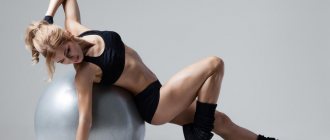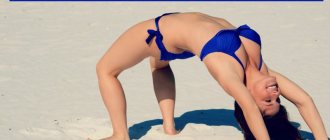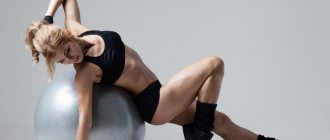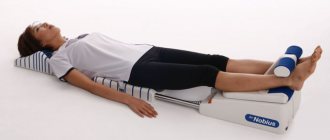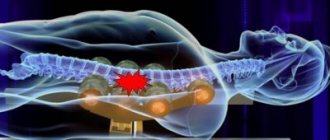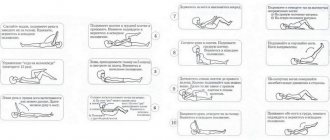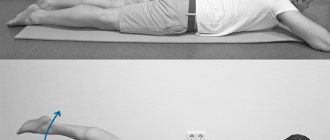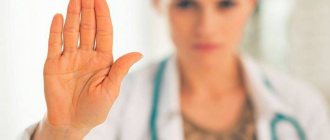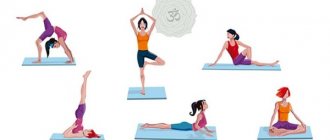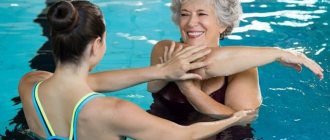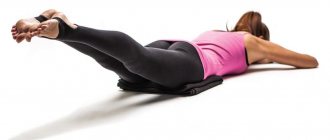Poor posture in childhood and adolescence is common. This is due to the rapid growth of the skeleton, which the muscular frame cannot keep up with. As a result, scoliosis develops, a disease whose treatment begins from the first days of diagnosis. The approach to this issue is always comprehensive and includes physical therapy exercises, massage, swimming and stretching. Particular attention is paid to exercise therapy, because regular exercises can not only slow down the process of deformation, but also eliminate its manifestations and achieve complete remission of the pathology.
How effective is exercise therapy?
Back exercises are prescribed for scoliosis with varying degrees of progression of the pathology. Therapeutic gymnastics is ineffective only at the last stage, when only surgery can restore beautiful posture. In other cases, the procedure allows for significant improvements. Exercises recommended by a doctor for scoliosis allow you to achieve:
- Reducing the number of tablets or completely abandoning medications during the treatment period.
- Returning elasticity and strengthening the tone of the back muscle corset.
- Activation of normal functioning of the heart muscle and lungs.
- Slowing down or completely stopping the deformation process in the spine.
- Improved mood and feeling of vigor.
- Relieving muscle fatigue.
- Elimination of lateral curvatures in the spine.
Exercises for scoliosis are not difficult, which allows you to perform them at home. But this requires strict adherence to technique and a gradual increase in physical activity. A complex of exercise therapy is prescribed by an orthopedist or vertebrologist, and is the basis of the chosen treatment tactics.
Scoliosis during the period of intensive growth of a child is especially dangerous, since the segments of the ridge are unstable and careless physical impact on them can lead to unpleasant consequences. Often this is a worsening of the angle of curvature, pinching of nerve endings, disruption of the heart or breathing. Therefore, specialists must work with young children to monitor the correct execution of each approach.
What is scoliosis?
Scoliosis is a congenital or acquired curvature of the spine as a result of deviation of the vertebrae to the right or left relative to their axis. The disease often develops in children aged 6-15 years, and occurs as a result of improper posture. Despite this trend, the number of adults suffering from scoliosis today is predominant.
It is impossible to cure scoliosis without the direct participation of the person himself, since the disease does not respond to any medications or physiotherapeutic procedures. The only way out is to completely change your lifestyle, following the rules of healthy eating and physical activity. Leading orthopedists strongly recommend exercise therapy for scoliosis, including therapeutic massage, reflexology, yoga, physiotherapy and wearing special orthopedic corsets.
Therapeutic exercises for scoliosis
Exercises for spinal scoliosis at home require compliance with a number of simple rules. They allow you to achieve results and ensure that each approach is performed correctly. Recommendations from specialists for exercise therapy include the following:
Exercise therapy for the spine with scoliosis
- The lesson is carried out only in a well-ventilated room, wearing comfortable clothes made of breathable material. It is better to give preference to loose pants and T-shirts made of natural fiber. The temperature in the hall is no higher than 18-20 degrees.
- The last meal before class is 2 hours before training; training on a full stomach is strictly prohibited.
- Every workout always begins with a warm-up. It allows you to warm up your muscles and effectively prepare them for the upcoming load. To do this, you need to move your arms, do pull-ups, bends in different directions. After such actions, the approaches will be much more effective.
- A set of exercises is performed according to the principle from simple to complex. That is, the training always begins with simple actions and gradually the load increases.
- On average, a workout should last 20-25 minutes and include loads on all muscle groups, and not just one zone.
- Performing exercises for thoracic scoliosis requires strict control of breathing; it should be smooth, deep, without shortness of breath or delays.
- The main goal of training is to strengthen the muscular frame, so it is extremely important to observe moderation, not to overload the spine, and not to exhaust yourself during exercise.
Exercise therapy is recommended to improve blood circulation in the area, develop the muscular system, to keep the spine in the correct position during the period of its growth. The main requirement is always regular training. Therefore, you should devote 20-30 minutes to performing the complex every day to obtain a lasting result. The exercise therapy complex is selected depending on the severity of the pathology, so the recommended exercises for stages 1 and 3 will differ significantly.
No ads 1
Exercises for stage 1 scoliosis
Exercises to correct scoliosis are effective at any stage of its development, but lasting results are achieved at the initial stage of development. Therefore, it is extremely important to undergo periodic preventive examinations to determine the condition of the back at different stages of the child’s growth. For grade 1 scoliosis, the following exercises are prescribed:
- Stand up straight, while inhaling, raise your arms up and try to stretch as much as possible on your toes, returning to the starting position.
- Feet shoulder-width apart, back straight, hands touching shoulders. Circular rotations are made with the elbows 20 times in each direction.
- Stand up straight, as you exhale, pull your left knee towards your right elbow, then repeat the action for the opposite limbs. It is enough to do 7-10 techniques.
- Lie on your stomach and imitate the process of swimming.
The exercise ends with walking around the room so that after the load the muscles calm down. It is important that after training you do not lose your breath, you feel a surge of strength and high spirits.
A simple complex to perform for grade 1 scoliosis
Exercises for stage 2 scoliosis
With scoliosis of the 2nd degree, the main task of any physical action is to correct existing curvatures, strengthen muscles, and reduce the negative manifestations of the disease. This will require more time; gymnastics is prescribed several times a week for 40 minutes. On average, it takes 2 years to achieve lasting improvement, provided that it is carried out regularly. At the second stage of development, the following exercises are included in the complex against scoliosis:
- Get on all fours and move around in a circle.
- Lie on your side, lift one leg up, fix it for a few seconds, return to the starting position.
- Get on all fours, while inhaling, arch your back upward, and while exhaling, return it to its original position. Repeat the approach 7-10 times.
- Lie on your stomach, clasp your arms above your head, and while inhaling, do not raise them so that your body forms an arc. Hold for a few seconds and return to the starting position.
At the second stage, you can do stretching if there are no separate doctor’s instructions for this. It allows you to improve the tone and elasticity of muscle tissue, restore normal blood circulation, and make your posture more aesthetic. In addition to exercises, to achieve a certain result, you will need to wear a corset according to a pattern chosen by a specialist, periodically visit a massage therapist and sleep on a hard surface.
Exercises for grades 3 and 4 scoliosis
Gymnastics classes for S-shaped scoliosis are carried out only under the supervision of a specialist. The use of a corrective corset and massage are required; in especially severe cases, surgery is prescribed if the angle of curvature is more than 50 degrees. Gymnastics are performed at least 3 times a week. It is strictly forbidden to overload muscles, intensively engage in fitness, squats, and outdoor games.
It is ineffective to treat scoliosis with exercise therapy in the final stages of development, but simple exercises can help maintain the back muscles in normal condition. Distinctive features of the training are a slow pace, as well as the elimination of excessive muscle loads, and the smoothness of all movements.
[node:field_similarlink]
Cosmetic defect or cause of disability?
By scoliosis, many understand all sorts of changes in posture in the form of stooping, hunched back, drooping of one shoulder relative to the other, etc. Often they are not given due attention and do not take care of the health of their spine or their child:
“It can’t be cured” “Who doesn’t have back problems now” “It will go away with age”...
But is it true that they can be ignored?
Normally, the spine has 4 curves: 2 lordosis (directed forward) and 2 kyphosis (directed backward). They increase the stability and mobility of the spinal column. There should be no bends to the side, otherwise it will not be able to perform a supporting function and ensure full body movements.
Scoliotic disease is a progressive, lateral curvature of the spine, which appears during a period of active growth and is accompanied by deformation of the chest, pelvis and disruption of the internal organs: lungs, heart, genitourinary system, etc. It develops as a result of changes in the shape of the vertebrae, their displacement forward/ back, left/right and rotation (torsion).
If the curvature of the spine is not accompanied by torsion, then this is not scoliotic disease, but scoliotic posture. It is formed due to low physical activity, incorrect body position when sitting, and poor physical development.
In Russia, the incidence of the disease in children and adolescents reaches 20%. According to statistics, by the end of school, every second child has manifestations of deformity. About 8–9% of these patients become disabled in childhood and almost 12% by the age of 28.
Such sad statistics are caused by the fact that scoliotic disease begins in childhood, develops very quickly, and it is almost impossible to cure it completely - you can only stop it. In teenage girls, the disease manifests itself 3–4 times more often than in boys, and progresses more actively due to the physiological characteristics of the female body.
In the early stages of the development of the disease, physical therapy and other conservative methods provide a good therapeutic effect - below we will look at which ones.
In advanced cases, correction of the curvature can only be achieved through surgery. Such operations are very traumatic, require a long recovery and also do not guarantee a complete recovery - the operated patients necessarily receive a disability group.
Thus, correct and timely diagnosis plays a major role in determining the prognosis of the disease and the treatment approach.
Gymnastics at home
Classes to eliminate spinal curvature are most often carried out at home. The important point is to exclude prohibited exercises and monitor the correctness of each approach. An ordinary mirror helps with this, or attracting a second person who will observe from the side. The whole complex consists of several stages:
- Warm up. These can be simple exercises aimed at warming up the muscles of the neck, back, chest and limbs. For this purpose, bends to the side, rotations, and circular movements of the shoulders are used. Effective warming up of the muscles directly affects the process of straightening the spine and allows you to prepare the muscles for the upcoming loads.
- Basic symmetrical exercises. Both with left- and right-sided curvature, the load is provided for the entire back as a whole. After all, it is impossible to eliminate the violation by directing force to only one side. Yoga approaches help well, for example, “Cat”, which involves bending and straightening the back on all fours, or “Embryo” pose. It involves stretching your back using your own weight.
- The final part of the training. It is somewhat reminiscent of the period of preparation for a lesson, and may include walking in place or rolling from toes to heels. An important task is to restore breathing and calm overheated muscles.
All proposed exercises are considered basic and therefore suitable for use by both adults and teenagers. If elements of stretching are involved, then a doctor’s consultation is required first, because some actions can do more harm than good. In general, stretching for scoliosis in the initial stages is not contraindicated.
No ads 2
Exercise therapy classes for scoliosis in the gym
Spinal curvature can be corrected through regular training in the gym. Such places have everything you need to get good results. Any lesson begins with a warm-up to prepare for the load. You can include the following exercises in the complex:
- Exercise on an exercise bike. 10 minutes of intense riding is enough to get a high-quality load on muscle tissue. At first, you should avoid using ellipsoids; treadmills are completely prohibited.
- Leg press. A special simulator is used for this. It is enough to do 3 sets of 10-15 repetitions. In this case, the bending angle should be small.
- Exercise with dumbbells. To begin with, you should choose devices of 0.5 kg. Take them in your hands while inhaling and move them in different directions. It will take 2 sets of 10 repetitions.
- Hyperextension. A universal exercise to strengthen the back muscles. The exercise on the simulator involves 3 approaches. In the first stages, it is not advisable to use weighting agents.
It is more convenient for adults to exercise in a gym, as it motivates them to complete the full complex and allows them to focus on the correct execution of each action. In specialized gyms, it is recommended to do gymnastics according to the Bubnovsky program, since the complex often involves the use of special simulators and devices.
Inadmissible exercises for the development of scoliosis of any degree
Prohibited exercises
With scoliosis, not all exercises and work with the muscular corset can be beneficial. Some actions can lead to serious complications and speed up the deformation process. Therefore, independent inclusion in a set of approaches without consultation with a specialist is not recommended. The following activities are contraindicated for any curvature of the spine:
- Oriental martial arts or martial arts.
- Any sagging on the horizontal bar or attempts to pull yourself up on it.
- Running, including on a treadmill or light in the park.
- Somersaults (especially dangerous when there is a curvature in the cervical spine).
- Football, volleyball, basketball classes.
- Any elements of acrobatics.
- Quick exercises, dynamic exercises.
- Any strength exercises, working with dumbbells or barbells.
- Stay in the lotus position for a long time.
- Torso rotation in a vertical position.
- Exercises aimed at one side, since asymmetrical loads significantly worsen the condition.
- Plank (except for the initial stages, if there is no prohibition from the doctor).
- Squats with weights.
- Dancing and gymnastic elements due to high load.
Some sports can place unwanted stress on the spine, causing injuries or sprains. In addition to those listed, these also include fencing, tennis, boxing; in most cases, they load only one side of the body and provoke severe curvature. You can replace them with swimming, yoga, Pilates, Nordic walking or skiing.
Prohibited activities can cause irreparable harm to the body in the presence of scoliosis, and therefore are completely excluded for the patient. At a severe stage of development of the deformation process, exercises are performed only within the framework of the complex recommended by the doctor.
No ads 3
Types of exercise therapy loads
Scoliosis is characterized by changes in the muscle corset due to curvature. Since in scoliosis the spine forms an arch, the muscles on its outer side are extremely stretched and tense.
On the inside of the arch, the muscles are pinched, spasmed and become atrophied over time. Therefore, during exercise therapy classes, various types of loads are used:
- exercises are performed alternately on only one side, while the opposite side is relaxed;
- an even load on the muscles on both sides, which is necessary for straightening the spine;
- alternating the load on different muscle groups to avoid overstraining some and undertraining others;
- General strengthening exercises to keep the whole body in good shape. During such exercise therapy exercises, the abs, arms, legs, and buttocks are involved.
Preventive exercises
Maintaining good posture is the main goal of every parent. Therefore, experts recommend that from the first days of life, organize activities for the child aimed at strengthening the muscular frame. Regular exercise or simple exercises on a fitball help with this. The following exercises are recommended to prevent scoliosis:
- Stand up straight, arms along your body, while inhaling, raise your shoulders up, hold for 2 seconds and return back. Do 10 reps.
- Stand straight, feet shoulder-width apart, while inhaling, raise your arms up and stretch with your fingers, stretching out on your toes. As you exhale, return to the original position.
- Perform circular movements with your hands, 5-7 times in each direction.
- Walk or march in place for a few minutes.
- Take turns pulling the knee towards the stomach, hands free, back straight and not bending during the execution.
- Lie on your back, raise your legs above the floor and cross them one at a time; this exercise is often called “scissors.”
- Get on all fours and, as you exhale, extend your left arm and right leg, hold for a few seconds and return to the starting position.
- Do push-ups on your knees.
Exercise caution with children if there are pathological processes in the thoracic or cervical region. The load level should be strictly controlled to prevent sprains or overstrains of individual sections.
One of the simplest and most effective ways to combat scoliosis is physical therapy. It allows you to slow down or completely stop the progression of the degenerative process in bone tissue, improve posture, and return a person to a normal quality of life. A complex of exercise therapy is always selected by a doctor, taking into account the severity of the pathological process and the general physical fitness of the patient, his age. In some cases, training can take place at home; in others, specialist supervision and treatment in a sanatorium are required.
Correction and prevention of spinal scoliosis with exercises: indications and contraindications
The first indication for prescribing exercise therapy is the identification of spinal curvatures, any, even barely noticeable, deformations or deviations from the norm. It is almost impossible for a non-specialist to track such changes in the early stages. Therefore, in case of predisposition to scoliotic metamorphoses (sedentary lifestyle, lack of physical activity, peculiarities of work activity, congenital or acquired predisposition, etc.), regular medical examination is required for possible pathologies of the spine and posture. When they are identified and an accurate diagnosis is established, with a determination, if necessary, of the severity of the disease (physical therapy can be prescribed in any of the four stages of the disease), a set of measures is prescribed to correct and prevent spinal scoliosis with the help of exercises.
Contraindications for prescribing physical therapy include:
- general depressed state of the body, weakness;
- bad feeling;
- the presence of other diseases requiring immediate medical intervention.
In any case, the need for treatment is determined individually and only by a specialist. Neglecting a doctor’s consultation, as well as self-medication with exercise therapy at home, is dangerous and can lead to serious consequences.
